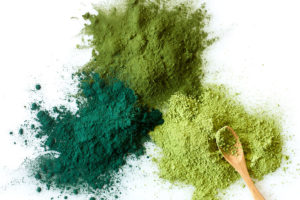Chlorophyll is a vital green pigment in all green plants and fresh Spirulina. It plays a crucial role in photosynthesis and is responsible for light absorption, which is essential for converting sunlight into chemical energy. The term “chlorophyll” originates from the Greek words χλωρός (chloros), meaning “green,” and φύλλον (phyllo), meaning “leaf.” This etymology reflects its primary association with green plant life.
The Role of Chlorophyll in Photosynthesis
Photosynthesis is the biochemical process through which plants and algae convert light energy into chemical energy stored in glucose. Chlorophyll absorbs light most efficiently in the blue-violet and red parts of the electromagnetic spectrum while reflecting green light, which gives plants their characteristic color. This absorption of light energy excites electrons within chlorophyll molecules, initiating a series of reactions that ultimately produce glucose and oxygen from carbon dioxide and water.
Health Benefits of Chlorophyll-rich Foods like Fresh Spirulina
Detoxification: Chlorophyll in fresh Spirulina aids in detoxifying the body by eliminating harmful toxins that lead to disease. It binds with these toxins, facilitating their removal from the body.
Healing Support: Chlorophyll in fresh Spirulina promotes healing, speeding up recovery from injuries or illnesses.
Cardiovascular Health: Chlorophyll has been shown to support cardiovascular health by improving blood circulation and reducing cholesterol levels.
Weight Management: Incorporating chlorophyll-rich fresh Spirulina helps with weight loss by promoting satiety and reducing cravings.
The Chlorophyll Powerhouse: Fresh Spirulina vs. Fresh Wheatgrass Juice
Regarding superfoods, both spirulina and wheatgrass juice are often celebrated for their numerous health benefits. These nutrient-dense foods are packed with vitamins, minerals, and antioxidants that can significantly enhance your overall well-being. However, one of the most compelling aspects of these superfoods is their chlorophyll content. Chlorophyll is a potent compound known for its detoxifying properties and ability to boost blood oxygen levels.
Understanding Chlorophyll
Chlorophyll is the green pigment found in plants, which allows them to absorb sunlight and convert it into energy through photosynthesis. This compound is vital for plants and offers several health benefits for humans. It has been shown to improve liver function and detoxification and even help wound healing. Additionally, chlorophyll can enhance the oxygen-carrying capacity of the blood, making it an excellent supplement for those looking to improve their overall health.
Fresh Spirulina: The Blue-Green Algae
Fresh Spirulina, a blue-green algae, is incredibly rich in nutrients, including proteins, vitamins (B1, B2, B3), iron, magnesium, potassium, and calcium. One of its standout features is its high chlorophyll content. Spirulina’s chlorophyll concentration makes it a potent detoxifier and an excellent addition to any diet to improve health.
Wheatgrass Juice: The Young Grass of the Wheat Plant
Wheatgrass juice is derived from the young shoots of the wheat plant (Triticum aestivum). It contains a variety of essential nutrients, such as vitamins A, C, E, and B complex (including B12), magnesium, selenium, cobalt, zinc, germanium, sulfur, calcium, iron, and amino acids. Wheatgrass juice also boasts significant amounts of chlorophyll and offers numerous health benefits, like aiding digestion and increasing oxygen levels in the blood.
Comparing Chlorophyll Content
When comparing fresh spirulina to fresh wheatgrass juice, specifically regarding their chlorophyll content:
- Fresh Spirulina: Known for its exceptionally high levels of chlorophyll.
- Fresh Wheatgrass Juice: Contains substantial amounts but falls short when compared directly to spirulina.
According to what I know from various studies and nutritional analyses:
Fresh Spirulina contains 575% greater amounts of chlorophyll than fresh wheatgrass juice.
This significant difference highlights spirulina’s superior capability as a detoxifying agent and its potential benefits in enhancing oxygenation within the body.
Why Chlorophyll Matters
The higher chlorophyll content in spirulina means it can offer more potent detoxification effects than wheatgrass juice. Chlorophyll binds with toxins in the body and helps eliminate them through natural excretory pathways. This process can lead to improved liver function and overall better metabolic efficiency.
Additionally, higher levels of chlorophyll can contribute to better tissue oxygenation. This can be particularly beneficial for athletes or individuals who engage in regular physical activity, as it may improve endurance and recovery times.
Conclusion
While both fresh spirulina and fresh wheatgrass juice are excellent additions to a healthy diet due to their rich nutrient profiles and health benefits:
Fresh Spirulina contains 575% more chlorophyll than fresh wheatgrass juice, making it a more potent option for those specifically seeking the detoxifying benefits associated with high chlorophyll intake.
Incorporating either or both into your daily regimen can provide substantial health benefits; however, if your goal is to maximize your intake of chlorophyll, fresh spirulina clearly takes the lead.
- National Institutes of Health (NIH)
- The NIH provides extensive research on various nutrients including detailed studies on superfoods like spirulina and wheatgrass.
- Journal of Food Science
- This peer-reviewed journal publishes scientific articles on food chemistry including comparative analyses on nutrient contents such as chlorophyll levels.
- American Journal of Clinical Nutrition
- A reputable source for clinical studies related to nutrition which includes research on the health impacts of consuming high-chlorophyll foods like spirulina and wheatgrass.






Recent Comments